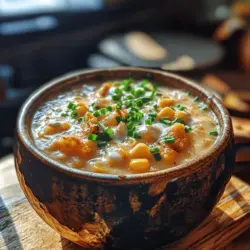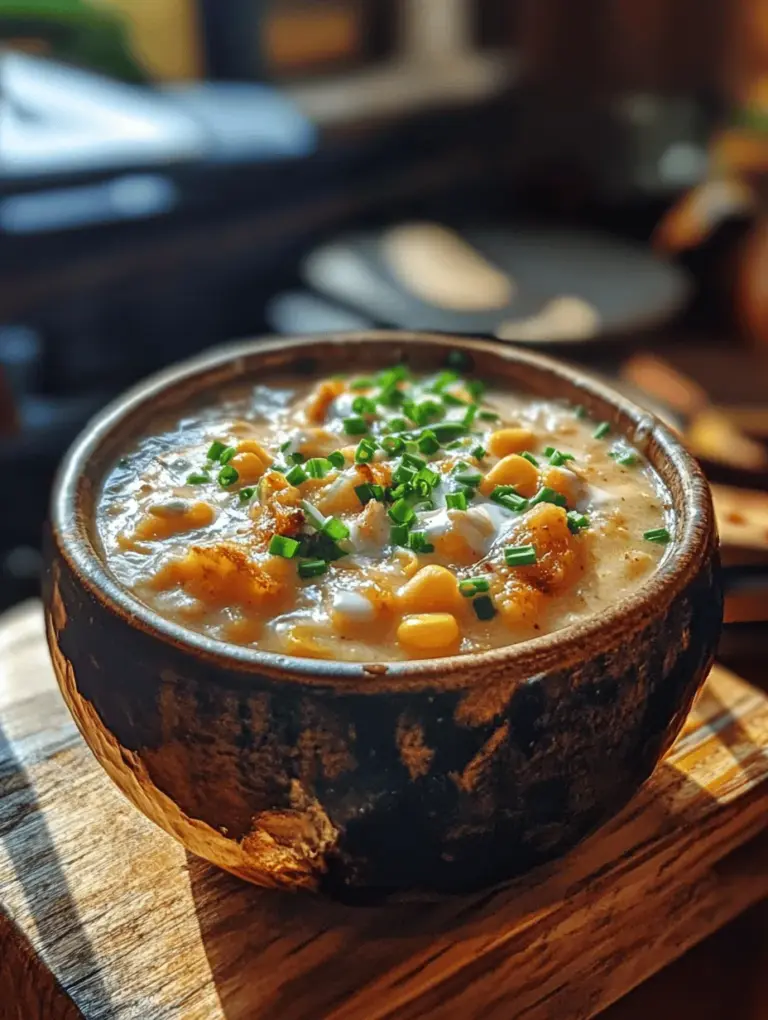Introduction
Creamy Corn Chowder is more than just a soup; it’s a warm embrace in a bowl, perfect for cozy evenings and family gatherings. This delightful dish, rich in flavor and texture, showcases the sweet, vibrant taste of corn, making it a favorite for many. Whether you’re enjoying it on a chilly autumn day or serving it at a summer barbecue, this chowder captures the essence of comfort food while being versatile enough to cater to a variety of dietary preferences.
What makes this recipe particularly appealing is its adaptability. You can easily modify it to suit vegan or dairy-free diets without sacrificing flavor or creaminess. By substituting heavy cream with coconut milk and using plant-based broth, you can create a delectable version that everyone can enjoy. This flexibility not only makes Creamy Corn Chowder a family-friendly option but also a great choice for gatherings, potlucks, and even meal prep for the week ahead.
In this article, we will explore the essential ingredients that make this chowder irresistible, delve into the health benefits they offer, and guide you through the initial steps of preparing this delightful dish. Let’s get started on making a chowder that will undoubtedly become a staple in your recipe repertoire.
Understanding the Ingredients
Fresh Corn and Its Nutritional Benefits
At the heart of any great corn chowder is fresh corn, which serves as the star ingredient. Not only does fresh corn bring a naturally sweet flavor to the dish, but it also packs a nutritional punch. Corn is an excellent source of fiber, which aids in digestion and helps keep you feeling full longer. It’s also rich in essential vitamins and minerals such as vitamin B6, thiamin, and folate, all of which play crucial roles in overall health.
Using fresh corn in your chowder ensures that you’re getting the best flavor and texture. When corn is in season, it’s at its sweetest and juiciest, enhancing the overall taste of the chowder. If fresh corn isn’t available, frozen corn can be a convenient substitute, retaining much of its flavor and nutrients.
Exploring Other Ingredients
– Onion and Garlic: These aromatic ingredients are foundational to many savory dishes, including chowder. Onions add sweetness and depth, while garlic provides a robust flavor that complements the corn perfectly. Both ingredients are also known for their health benefits, including anti-inflammatory properties and immune-boosting effects.
– Potatoes: An essential component of Creamy Corn Chowder, potatoes contribute to the chowder’s heartiness and texture. They help thicken the soup while providing a creamy mouthfeel. When selecting potatoes, Yukon Golds or red potatoes work well due to their smooth texture when cooked.
– Red Bell Pepper: Not only does red bell pepper add a pop of color to your chowder, but it also brings a touch of sweetness that balances the dish’s richness. Additionally, red bell peppers are high in vitamin C and antioxidants, making them a nutritious addition.
– Vegetable Broth: The choice of broth can significantly influence the flavor of your chowder. Homemade vegetable broth offers a depth of flavor that store-bought versions may lack, but using a high-quality store-bought broth is a convenient alternative. Look for broths with minimal sodium to control the dish’s overall saltiness.
– Heavy Cream vs. Coconut Milk: Depending on your dietary preferences, you can choose between heavy cream and coconut milk. Heavy cream adds a rich, velvety texture, while coconut milk provides a dairy-free alternative that still maintains creaminess. Coconut milk also imparts a subtle sweetness that pairs well with corn, making it a popular choice for vegan versions of this chowder.
– Spices: The right spices can elevate your chowder from ordinary to extraordinary. Smoked paprika adds a hint of smokiness, enhancing the soup’s flavor profile, while thyme contributes a fragrant, earthy note. Together, these spices create a well-rounded taste that complements the sweetness of the corn.
Preparing the Creamy Corn Chowder
Step-by-Step Instructions for the Best Results
Sautéing Aromatics
The first step in preparing Creamy Corn Chowder is to sauté the aromatics, which include onions and garlic. This essential step develops the flavors that will form the base of your chowder. Start by heating a generous amount of olive oil or butter in a large pot over medium heat. Add the diced onions and sauté them for about 3-5 minutes until they become translucent. This process releases their natural sweetness and adds depth to the chowder.
Next, add minced garlic to the pot. Sauté the garlic for an additional minute, stirring frequently to prevent it from burning. The aroma that fills your kitchen at this point will be a tantalizing indication of the delicious chowder to come.
Adding Potatoes and Corn
Once your aromatics are ready, it’s time to add the diced potatoes and fresh corn to the pot. Make sure you cut the potatoes into uniform pieces to ensure even cooking. Stir the mixture well, allowing the potatoes to absorb the flavors from the sautéed onions and garlic.
Next, pour in your vegetable broth, ensuring that the potatoes and corn are fully submerged. Bring the mixture to a gentle boil, then reduce the heat to a simmer. Cover the pot and let it cook for about 15-20 minutes or until the potatoes are tender. This step is crucial, as it allows the flavors to meld together while the potatoes soften.
As the chowder simmers, you can prepare to add the final ingredients that will make this dish truly creamy and delicious.
In the next section, we will continue with the remaining steps to finish your Creamy Corn Chowder Delight, providing you with tips and tricks to ensure your chowder turns out perfectly every time. Stay tuned for more details on how to create this comforting dish that is sure to impress your family and friends.

Tips for Pouring in Broth: How to Achieve the Perfect Simmer
Achieving the ideal simmer is key to a flavorful creamy corn chowder. When pouring in the broth, do so gradually while stirring the mixture continuously. This technique ensures that the vegetables and spices are evenly distributed, allowing for a harmonious blend of flavors. A gentle simmer is crucial; too vigorous a boil can lead to overcooked ingredients and an undesirable texture. Aim for small bubbles breaking the surface rather than a rolling boil. This allows the corn to soften while retaining its natural sweetness, creating a base that’s rich and sumptuous.
Blending Techniques for Desired Texture
The texture of your corn chowder can be tailored to your preference using different blending techniques. If you enjoy a smooth, creamy consistency, a traditional blender is a great choice, as it can thoroughly purée the soup. However, if you prefer a chunkier texture with some bits of sweet corn and potatoes, an immersion blender is ideal. This handy tool allows you to control the blending process directly in the pot, making it easy to pulse until you reach your desired consistency without having to transfer hot liquid.
Immersion Blender vs. Traditional Blender
Using an immersion blender is not only convenient but also minimizes the risk of splattering, which can be a concern with traditional blenders. Simply submerge the immersion blender into the chowder and blend until you achieve a creamy texture, stopping when you see some chunks of corn and potato remaining. On the other hand, if you opt for a traditional blender, be sure to allow the soup to cool slightly before transferring it in batches to avoid burns. Both methods can yield delicious results, so feel free to choose based on your comfort and kitchen tools.
Tips for Achieving a Creamy Consistency While Maintaining Some Texture
To strike the perfect balance between creaminess and texture, consider blending only a portion of the chowder. For instance, you can blend half and leave the rest chunky. This method adds depth and interest to your dish, allowing the vibrant flavors of corn and potatoes to shine. Additionally, when blending, pulse the mixture rather than blending continuously. This technique helps maintain some of the ingredients’ integrity, providing satisfying bites throughout the chowder.
Incorporating Cream: Achieving the Right Creaminess
Incorporating cream into your chowder elevates it from a simple soup to a rich, decadent delight. Heavy cream is the classic choice, lending an incredibly smooth and luscious mouthfeel. For a dairy-free alternative, coconut milk provides a similar creaminess with a hint of sweetness that complements the corn wonderfully.
Best Practices for Mixing in Heavy Cream or Coconut Milk
To achieve the perfect creaminess, add the heavy cream or coconut milk at the end of the cooking process, just before serving. This prevents curdling and helps to preserve the smooth texture. Gently stir the cream into the hot chowder, allowing it to warm through without boiling. If you prefer a lighter version, consider using half-and-half or a combination of milk and cream. Regardless of your choice, the goal is to create a silky, satisfying finish that envelops the palate.
Serving Suggestions and Pairings
When it comes to serving your creamy corn chowder, presentation can enhance the overall dining experience. Aim for the ideal serving temperature of around 165°F (74°C) to ensure the flavors are at their peak. Ladle the chowder into bowls, allowing the vibrant yellow corn and green herbs to shine through.
Tips for Garnishing with Fresh Chives or Parsley
Garnishing your chowder not only adds visual appeal but also elevates the flavor. Fresh chives or parsley work beautifully as toppings. Simply chop them finely and sprinkle a generous amount over the chowder just before serving. This adds a fresh, herbal note that contrasts nicely with the creamy texture.
Complementary Side Dishes and Beverages
Creamy corn chowder pairs wonderfully with crusty bread, perfect for dipping and soaking up the delightful soup. A simple green salad with a light vinaigrette can provide a refreshing balance to the richness of the chowder. For a heartier accompaniment, consider serving grilled cheese sandwiches or a side of roasted vegetables.
When it comes to beverage pairings, a chilled glass of white wine, such as a Sauvignon Blanc or Chardonnay, complements the sweetness of the corn. For a non-alcoholic option, consider sparkling water with a hint of lime, which adds a refreshing touch to your meal.
Nutritional Analysis of Creamy Corn Chowder
Understanding the nutritional profile of your creamy corn chowder can help you enjoy it as part of a balanced diet. A typical serving (about one cup) contains approximately 250-300 calories, depending on the amount of cream used.
Breakdown of Calories, Fats, Proteins, and Carbohydrates
– Calories: 250-300
– Total Fat: 10-15 grams (if using heavy cream)
– Saturated Fat: 5-8 grams
– Protein: 5-7 grams
– Carbohydrates: 35-40 grams
– Fiber: 3-5 grams (from corn and potatoes)
This chowder provides a good source of fiber and carbohydrates, making it a filling meal. However, if you are looking for a lighter or healthier version, consider substituting heavy cream with low-fat milk or using coconut milk for a dairy-free option.
Variations for Dietary Restrictions
For those with dietary restrictions, creamy corn chowder can easily be adapted. For a gluten-free version, ensure you use gluten-free broth and thicken the soup using pureed corn or potatoes rather than flour. Vegan options are also achievable by replacing heavy cream with coconut milk or cashew cream and using vegetable broth instead of chicken broth.
Conclusion
Creamy corn chowder is a comforting and versatile dish that brings warmth and joy to any meal. Its rich flavors and creamy texture are sure to please both family and friends, making it a great choice for gatherings or cozy nights in.
This recipe invites creativity, encouraging you to experiment with different ingredients, spices, and garnishes that suit your taste. Whether you stick to the classic version or modify it to fit your dietary preferences, the essence of creamy corn chowder remains— a delicious bowl of goodness that warms the heart.
Cooking is an art, and sharing meals with loved ones is one of life’s greatest joys. Embrace the process, enjoy the flavors, and relish the moments spent at the table.

